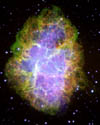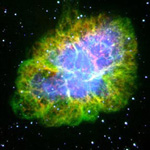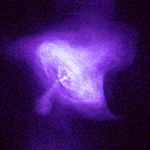For millions of years a star shined in the far off constellation of Taurus. So far away, and so faint that even if our eyes were ten thousand times more sensitive, the star would still not be visible to us on the Earth. Then one day, in a few seconds, all that changed. An explosion beyond belief in its intensity lit up the heavens; it still shines, almost one thousand years later....

It was just another day in the year 1054. People walking around the marketplace,
discussing the current gossip about the latest advance of the barbarian hordes to
the north. In places, it was raining, perhaps, but SOMEWHERE it was probably
clear...
Within one minute, a dazzling light ten billion times more energetic than that of the Sun burst into the daytime heavens. Although so far away that it seemed a mere pinpoint, Chinese astronomers reported that the new heavenly jewel outshone all the stars visible in the sky. Its intense glow ruled the sky for months. You could READ by its fiery light.
The scholars of the day called them "guest stars", and probably calmed many a fearful citizen when they informed them that one had appeared in 1006, a mere 48 years ago, and that all who witnessed the event survived.
For several hundred days, the star was visible during the day, slowly, slowly fading toward the obscurity from which it emerged. The Crab Nebula had just been created.


Left Image: Palomar, PRC96-22a, ST Sci OPO, May 30, 1996, J.Hester and P. Scowen (AZ State Univ.) and NASA
Right Image: Carnegie Observatories, Washington, D.C.
Almost one thousand years later, the Crab Nebula still glows, and informs us of its fascinating story. It begins about 30 million years ago, when a rather large star began to radiate. Because of its size, it was destined to live an abbreviated life (from a cosmic point of view!), compared to the 10 billion years or so that is allotted to our own Sun. As a reward, perhaps, it was also destined to go out in a blaze of glory, for 100 days rivalling the light output of our entire galaxy containing one hundred billion stars.
At the close of its existence, this star recycles itself into the fabric of our universe. It simply explodes, not from its surface as do other less massive stars, but from the very core of its central fire. We are still witnessing this explosion, 7000 years after it occurred.
"Wait! You made a mistake," I hear you cry. "You just said the explosion happened in 1054! That's only 1000 years ago."
No Mistake has been made. It really did happen 7000 years ago.
The energy of the explosion was stupendous. Most of the star's mass is ejected at speeds of hundreds of kilometers per SECOND, becoming a cosmic vacuum cleaner of sorts, sweeping up all the gas in its path as it rushes outward from its former stellar home. Where the gas it encounters in the depths of space is rather concentrated, it slows down a bit more than where the gas is more rarified. Thus, the nebula appears fairly irregular, with the beautiful wisps, knots, and filaments that we still see today.
But what powers the nebula? How can we still see it after all these years? What makes it glow so steadily in the sky? The answer was to wait until very recently, 1967, when a strange radio signal was detected in the sky....

Blinking Pulsar
Although the Crab Nebula has been studied with telescopes for hundreds of years, it wasn't until 1967 that we began to understand the nature of the central engine that powers the Crab Nebula and enables it to glow. In that year, Jocelyn Bell, a student at Cambridge University in England, found a curious object in the constellation of Vulpecula. It seemed to be a "star" whose light blinked on and off, apparently much like a lighthouse beacon, with an amazingly precise frequency of once every 1.33728 seconds.
What could possibly DO that, in the sky, with such accuracy? Soon others were found, and astronomers jokingly called them LGMs for "Little Green Men." (What else could possibly be responsible for such bizarre behavior?)
Shortly thereafter, one such beacon was discovered at the center of the Crab Nebula, beating 30 times per second! Not only that, it could be seen throughout the electromagnetic spectrum, from radio waves through X-rays. Although later called "pulsars," it turned out that rotation is responsible for the clock-like regularity of the pulses. And the star? Well, it turned out to be something so strange and exciting that it almost defies description....
Despite the intensity of the supernova explosion that created the Crab Nebula, some stellar material stayed behind, and survived intact. An object called a neutron star was left. Crushed by the titanic forces of the explosion, about 2 solar masses of material remained out of the original 8-12 solar masses of the exploded star. But, the crushed material was compressed into a volume no larger than that of Manhattan Island, and its supporting bedrock! A mere thimbleful of this star-stuff would contain the same mass as about 10 million full sized, African elephants!! These stars are unbelievably dense!
And just as an ice skater spins faster and faster as she pulls her body closer and closer to her rotation axis, as this star collapsed from the originally slowly spinning parent object, it too began to spin more and more rapidly. The magnetic field also increases greatly in strength. The combination of rapid rotation and strong magnetic field is believed to generate jets of high-energy particles that produce the pulses.
Several years after this discovery, it was found that the Crab Pulsar was very, very gradually slowing down! This meant that it was losing energy. Remarkably, when we calculated this loss of energy, it turned out to be almost precisely the amount of energy necessary to power the Crab Nebula itself!!! In other words, the pulsar in the Crab was "feeding" the nebula just the right amount of energy to illuminate it as we see it today. The Crab Nebula is truly a beautiful sight in the sky, when viewed through a telescope, and its history and evolution are no less remarkable. It is probably the single most studied object in the heavens today. Who knows what the future holds for it, and for our understanding of the processes that shape its evolution?
The Crab Nebula has continually surprised us over the centuries. Although visible for almost 1000 years, it ceaselessly changes its appearance and structure. With the advent of satellites that can probe different parts of the electromagnetic spectrum, we have increased our knowledge of this strange object manyfold.
One of the most unusual discoveries was that the optical filaments of the nebula are apparently still being accelerated almost a millenium after the initial explosion! Imagine a bicycle that goes even faster after you stop pedalling! Clearly something has to be providing more energy to both the bicycle and the Crab Nebula for this to happen.
When we look at the Nebula in a different light, we can examine different physical processes that may exist there. X-ray telescopes provide such a possibility. Because of their higher energies, the X-ray emission gives us a different look at the Nebula.
In the amazingly detailed image shown here from the Chandra X-ray Observatory, we see that high-energy X-rays are concentrated toward the center of the nebula. Spectacular ring-like structures around the central pulsar are visible, as are jets blasting away from the pulsar perpendicular to the rings.
As scientists continue their study of the Crab, the new Chandra data will provide an important piece of evidence to the puzzle of how the pulsar's power gets into the Crab Nebula. You can be sure that there will be some surprises in store for us. Stay tuned for the results!
We have come full circle. The universe ensures that for every end there is a new beginning. In its death throes, supernovas enrich the interstellar medium so that new stars and planets can be born. In fact, every atom of calcium in every bone in your body, every atom of iron in your blood, was shot out of a star billions of years ago, before the birth of our own Sun. We are literally and actually Children of the Stars.
So think about what it must be like to witness such a monumental event as a supernova. It may happen any day now in our galaxy; we are long "overdue" for one.

Why not draw a picture about it, or write a story. If you send your work to us,
either by e-mail or the address below, we will post a sample of them on our web
page. Please include your name, age, and location. We are sorry, but we cannot
acknowledge or return any work.
c/o Professor Terry Matilsky
Department of Physics
Rutgers University
Piscataway, NJ 08855-0849





